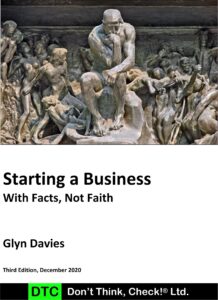
Introduction
Marketing empirical generalisations are observations about marketing causes and effects that hold for a broad number of product categories, demographics, environments, media, and formats. When marketing empirical generalisations have broad applicability and utility, they can almost be thought of as marketing laws.
What follows may contradict your experience, and this can be due to many factors. You are possibly mistaken. The conditions needed to obtain repeatable experimental results are difficult to establish, maintain, and may not align with your realities. Your case may be unique, not be relevant, or not studied and reported. And it almost doesn’t need repeating, studying humans is a fraught and error-prone exercise.
If nothing else, the marketing empirical generalisations below should give pause to unsubstantiated zealous methods. Instead, care should be taken to understand which marketing methods work, when they work, why they work, where they work, and whom they work with. And with all of that, how strong or correlated is the effect (sales response) to the cause/stimuli (advertisement)?
For example, using the generalisation below Advertising Clutter On Facebook, clutter in general and clutter specifically on Facebook and its effect on users is generalised and reported. Clutter diminishes users ability to remember advertisements. Additionally, some targeting, whether implicit or explicitly performed, often biases reach to brands’ heaviest and most loyal buyers. This practice is unlikely to help with brand growth, which needs advertising to reach non-buyers and light buyers. But the point made in the generalisation is that the effect of clutter on marketing objectives will also be dependent on the manner in which Facebook is used.
In some cases, the generalisations can be taken as a guide for how to do or not to do something as the basis for an experiment, such as A/B testing to determine what works for your brand, in your market, at this time, with the existing technology, and within the social and cultural imperatives.
The challenge with generalisations is that they are simply that, generalisations. Their relevance to a particular business will likely be positioned on a continuum of relevance from not at all relevant at one extreme to completely relevant at the other. And relevance could also change or vary with context. For example, Facebook may not be suitable to support and grow a fan base for a single-use/single-purchase product (for instance a wheelbarrow), but Facebook may be beneficial to gain access to specific demographic groups that are likely to buy that product.
Note: A related post is Does Customer Loyalty Exist? The post discusses customer loyalty and reaching non-buyers and light buyers for brand growth.
References
This post is based on: Wind, Y., Sharp, B., & Nelson-Field, K. (2013, June). Empirical Generalizations: New Laws for Digital Marketing – How Advertising Research Must Change. Journal of Advertising Research.
Definitions
| Term | Definition |
| Media Synergy | Refers to the combined effect of independent media being greater than the sum of the individual effects. |
| Earned Media | Where buyers become the channel. (Forrester Research). Media activity created and or shared by buyers, journalists, and the public, not by the business or its agents. (Wikipedia, August 2020). For example, buyer Word Of Mouth (WOM) and digital content sharing. |
| Owned Media | A channel a brand controls. (Forrester Research). Media activity created by the business or its agents and presented on channels that are owned and or controlled by the business. (Wikipedia, August 2020). For example, brochures and business/brand blog. |
| Paid Media | Where a brand pays to leverage a channel. (Forrester Research). Media activity created by the business or its agents and presented on channels that are NOT controlled by the business. (Wikipedia, August 2020). For example, television and Facebook advertising. |
| Reach | Refers to the proportion of the total (demographic) population, who could potentially be exposed, or who were exposed to advertising. |
Brand Recall
Empirical Generalisation:
Consumers more readily notice and recall brands that they already use. For earned, owned, and paid media consumer
touchpoints (a point of contact), consumers are on average 1.7 times (the user multiplier) more likely to recall seeing/hearing brands that they use than non-users buying in the same category.
Notes:
- The smaller the multiplier, the greater the likelihood that a brand is recalled equally well by both users and non-users.
- Larger brands have a greater ability to reach non-users (and users).
- The multiplier does not indicate total recall. For example, the user/non-user recall multiplier for larger brands, such as Telecoms is 1.5 compared to 2.3 for relatively smaller brands such as Financial Services. Still, for both users and non-users, the total recall for Telecoms is approximately twice as great as for Financial Services.
- The amount of brand recall difference between users and non-users is higher for smaller brands (but smaller brands are recalled less often than larger brands).
- In developed markets, in contrast to emerging markets, it is harder to reach non-buyers because of the greater amount of branding clutter.
- In emerging markets, television advertising is most effective.
- Non-buyers are harder to reach with earned touchpoints than with paid media.
- Non-buyers (and buyers) are easier to reach with paid media.
- Existing buyers are easier to reach with earned and owned media.
Advertising Clutter on Facebook
Empirical Generalisation:
The advertising clutter on Facebook, and similar platforms, diminishes users’ ability to remember advertisements.
Notes:
- There are many ways to use Facebook:
- As a proxy website instead of a business website.
- A Facebook platform presence to redirect audiences to the business website.
- As a mandatory/fashion business accoutrement, possibly leaving Facebook’s full potential unexplored and underutilised.
- A brand fan community resource and forum (with various degrees of formality).
- A message board for questions and answers, instead of or as well as a website FAQ.
- A channel for proactive communication from the business to existing buyers.
- A channel for proactive communication from potential buyers and existing buyers to the business.
- As a means to access demographic groups in Facebook’s database of approximately 2.5 billion users (Facebook data, December 2019) per month.
- Some combination of the above.
- Unless Facebook is actively used as a promotional platform, to not only satisfy existing buyers but also to reach out to non-buyers and light buyers through Facebook’s user database, then Facebook will primarily reach a brand’s heaviest and most loyal buyers. However, brand growth needs advertising to reach non-buyers and light buyers. If brand growth is a goal, then brand activity on Facebook cannot be passive.
- Advertising clutter, on say, television and radio (and now Facebook) is well recognised as stimulating avoidance behaviours and impairing brand recall. The presence of clutter should be considered when planning advertising campaigns.
- There is a greater chance of recalling advertisements when they are presented in lower and low clutter environments.
- Advertising clutter can occur in three dimensions:
- Quantity of advertisements (biggest negative effect).
- The competition from similar brands in the same category.
- The degree of intrusiveness (forced exposure that can’t be avoided).
- The quantity of clutter has several effects:
- Overload effect – high levels of competing stimuli reduce the ability (and desire) to absorb and make sense of messages.
- Selective attention – forces audiences to filter and only pay attention to what they deem to be relevant.
- Triggering avoidance behaviours – in response to perceived threat(s) to freedom(s), the reactance effect; perceptual or judgemental changes and or behavioural effects such as opposition or aggression.
- There is a trade-off between the amount of advertising clutter and the advertising price, with high-clutter environments such as Facebook being cheaper.
- A doubling of clutter does not proportionately halve a brand’s recall.
- Perhaps because of their greater mental availability, making them easier to see and remember, larger brands are less affected by clutter.
- Low clutter environments are more important for new brands and for smaller brands.
Digital Campaign Delivery
Empirical Generalisation:
The use of cookies to measure unique website visitors is unreliable because a large number of internet users frequently purge cookies. The measurement of cookies will overestimate unique visitors as well as reach and will underestimate delivered frequency by 2.5 times.
Notes:
- Other cookie-count related problems:
- One person can use multiple devices, for example, a work computer, a home computer, and a mobile phone. Use of multiple devices will result in more than one cookie per person.
- Multiple people can use the same device, for example, a home computer, and this will result in multiple people per cookie.
- A consequence of the above 2 problems, targeting specific demographic groups becomes more inaccurate with each variable added. For example, when one variable is used (say men), cookie-based delivery reaches targets approximately 70% of the time. When a second variable is added (say men ages 25-35), the targeting accuracy falls to an average of around 48%, and when a third variable is added (say men ages 25-35 who own a dog), then targeting accuracy can fall to around 11%.
- Using cookies to target behavioural segments (say visitors to national park sites, viewers of wildlife documentaries) also suffers from significant errors.
- Although the use of cookies can suggest that advertisements have been seen by the computer user, on average one in three advertisements are not seen. This can occur when an advertisement is presented on a page that the user does not scroll down to, when the user moves off a page before the advertisement can be fully displayed, and when the user scrolls past an advertisement or moves to another page without seeing it.
- Geographic targeting based on IP address is quite accurate (around 93-96%) at a country level, but the accuracy drops off as the targeting area becomes smaller.
- Core dimensions of advertising delivery:
- Reach and frequency – the percentage of the population reached at least once with an advertisement and the average number of advertisements delivered per person.
- Target audience – the extent to which the correct demographic was reached.
- In-view – 50% of an advertisement’s pixels are in the view for one second or longer.
- Brand safety – advertisements only delivered to sites considered as safe for the brand, for example, not adult content sites.
- Target geography – the extent to which the desired geography is reached.
- Non-Human Traffic (NHT) – the extent to which advertisements are served to non-humans such as internet spiders and bots.
- In-flight monitoring, measurement, and modification of advertising campaigns improve Return on Investment (ROI).
Sales Effects of Cross Media Advertising
Empirical Generalisation:
Where people are exposed to a single television or online advertisement, in a majority of cases, a short-term increase in sales is realised. With online exposure, the short-term increase in sales is less consistent.
Mixed media advertising campaigns may be successful in broadening reach, but little to no cross-media synergy effect is apparent. This counter-intuitive result may be from heavy viewers likely to have seen more competitive clutter, which is known to dampen the sales effect of a brand. More research is needed to understand the conditions.
Notes:
- For brands to grow, they need a broad reach (across many demographic groups).
- There is the belief that multi-media campaigns (integrated marketing communications) will obtain the reach desired.
- Television is still capable of large reach. When online media is added, the extra reach achieved is approximately 1/4 unduplicated and 3/4 duplicated.
- Amongst those who are exposed, television stimulates short-term sales. Approximately 70% of advertising has a positive effect.
- Advertising copy must clearly identify the brand – creativity should not come at the expense of clarity of the underlying message.
- Higher frequency of advertisements typically result in extra sales, but with diminishing returns that follow a convex response (upside-down U curve).
Cross Media Synergy Versus Cross Device Synergy
Empirical Generalisation:
Provided the advertisements are in the same format (video, audio, website), then the effect on measures of persuasion, ad-awareness, or ad-likeability, are the same on any combination of devices (television sets, radios, personal computers).
Where the format is different (interactive vs. non-interactive) and where interaction differs (push buttons versus mouse versus touchscreen), then synergistic sales effects are possible. These effects suggest there are benefits to the timing and sequencing of advertisements on different devices.
Notes:
- Advertisement format differences, but not device differences, generate multiplicative within-subjects synergy effects.
- Four representative measures of advertising effectiveness are:
- Awareness (brand recall).
- Advertising likeability (agreeable–disagreeable, clear–imprecise, interesting–boring, and well structured–badly structured).
- Persuasion – brand attitude (bad-good).
- Persuasion – purchase intention.
Patterns of Reach With Multi-Media
Empirical Generalisation:
The first advertising exposure has the most effect, with subsequent exposures having positive but diminishing sales responses. This suggests that our first exposure should be designed and timed to be most effective.
To reach audiences closely matching brand and category profiles, emphasis should be given to television, giftpacks, in-store displays, and outdoor advertisements. To reach heavy category users, consideration should be given to public relations, web sites, sampling and, to a lesser extent, print, radio, online, events, and on-trade activities.
Notes:
- Social media and positive word of mouth skew towards (are strongly aligned with) heavy brand buyers and continued category usage. These buyers are already aware of the brand and its benefits but may also have bought all that they need or can.
- Reaching as many category buyers as possible is best to grow the brand; not just focusing on heavy buyers.
- As the brand grows, to continue that growth, emphasis should shift to penetration over increasing loyalty.
Advertising Efficiency
Empirical Generalisation:
Media should be purchased based on what will likely be seen by the target market, not some demographic target. When this is done, there is a 10 to 25 percent improvement of efficiency of the purchase.
Notes:
There is a limit the increase in efficiency; no further efficiencies will be obtained when the target audience is greater than 20 percent of the viewing population.
Price Promotions
Empirical Generalisation:
Price promotions mostly attract and are bought by existing users of the brand.
Notes:
Price promotions reward frequent buyers who would have bought anyway, but now buy at a discount instead of full price. In this case, margin is simply given away for no long-term benefit.
Brand Loyalty
Empirical Generalisation:
Smaller brands get effected by the so-called double jeopardy law, that’s where they get “hit” twice, meaning, they have fewer buyers where those buyers buy slightly less. For example, if a large brand has buyers buying at a rate of 10 items per period, the buyers of small brands buy at less than 10 items per period.
Notes:
- Brands grow primarily by increasing sales to infrequent buyers and to non-buyers, meaning, by increasing their penetration, not their loyalty.
Return On Investment (ROI)
Empirical Generalisation:
The response to advertising decreases with subsequent exposures, which means that the greatest marginal response is from the first exposures. This response to frequency of exposure follows a convex (upside down U) curve.
Notes:
- There are marginal responses and therefore marginal increases in sales with too much advertising within a fixed period.
- There is a better return on investment when the focus is on maximising reach rather than on increasing frequency.



